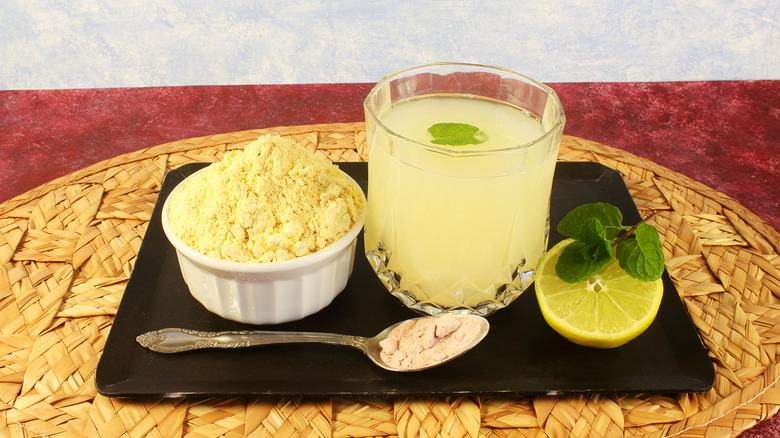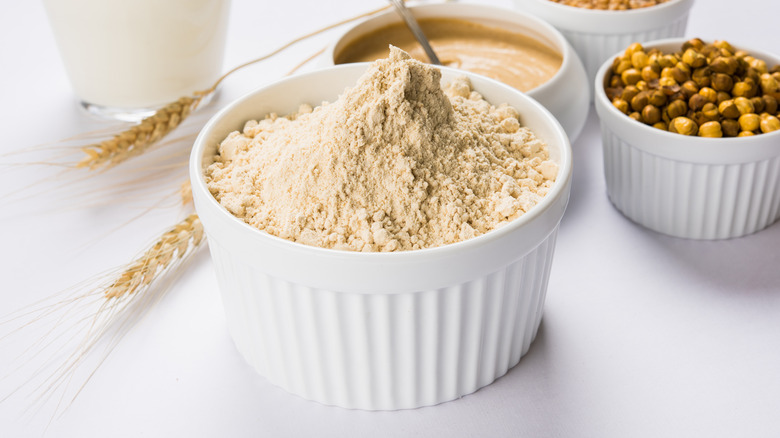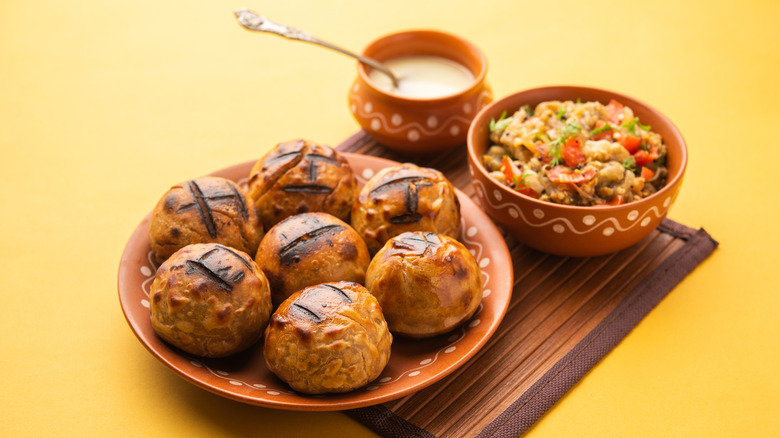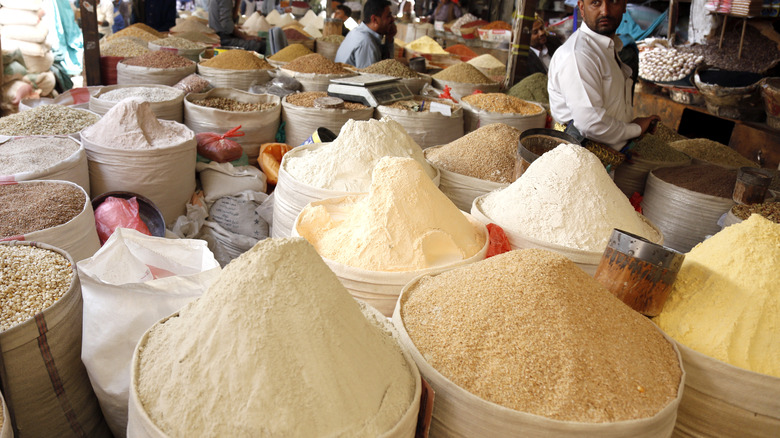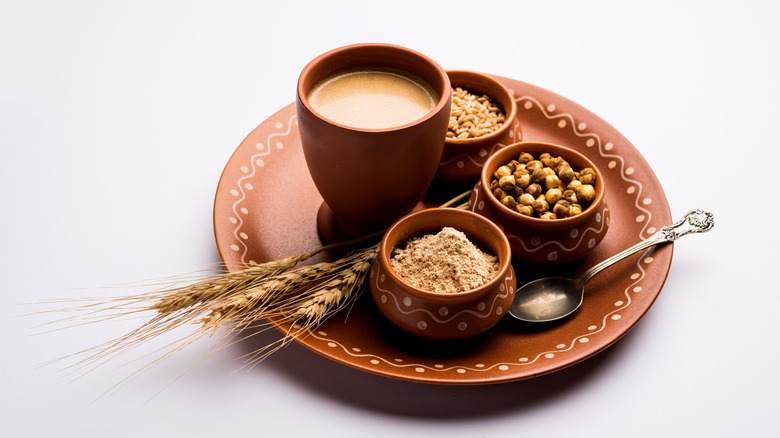What Is Sattu Flour And How Do You Use It?
When summer arrives, it brings along with it psychological encouragement to live an active lifestyle and make the best of endless reasons to be happy — vacations, traveling, backyard barbeque parties, unwinding at tranquil beaches, and so much more. While people in the United States happily embrace the summer season, it can be a blessing or a curse in other parts of the world. Take an example of the Indian subcontinent, where countries like India and Pakistan face the worst heat waves, and the combination of heat and humidity can make summer literally unbearable.
So how do people in these countries survive the oppressive heat and cool down? Well, they drink traditional summer drinks like the delicious mango lassi. Refreshing summer drinks are considered a quotidian necessity, and one such popular drink is sattu, which some even call a natural summer cooler, per Rumki's Golden Spoon. It is believed that regular consumption of this healthy drink can help improve stomach health and prevent heatstroke (via Onlymyhealth).
Most of you probably never heard about sattu, let alone tasted it. So, why exactly is this type of flour so prevalent in India and Pakistan that it is commonly referred to as the "poor man's protein" (per Slurrp)? So, without further ado, let's dig in to learn more about sattu flour.
What is sattu flour?
Sattu is a protein-rich flour native to India, Nepal, Bangladesh, and Pakistan. It is traditionally made by roasting the Bengal gram (chickpeas or other pulses and legumes) in the sand. It is worth noting that sattu and gram flour (besan) are different. An ingredient roasted and grounded into a powder is sattu, and since gram flour is grounded in horse gram, it can only become sattu once roasted. Sattu doesn't taste bitter but you can feel the tiny particles when drinking or eating it.
Originally, sattu flour was prepared by roasting maize, barley, pigeon gram, black gram, green pea, kulthi dal (horse gram), and khesari pulse, Deccan Herald notes. The region's impoverished people heavily relied on this ingredient because it was inexpensive and easy to cook. Those who couldn't find anything else to eat would mix sattu with water, hence the name "poor man's protein."
Historians haven't been able to trace the history of sattu to one single origin. However, there is a consensus that it was widely consumed during wars due to its instant pick-me-up, energy-boosting properties, and easy-to-eat nature. According to one legend, the protein-rich superfood originated in Tibet, where it is called Tsampa. It is said to be the staple food of monks who had to travel to distant places and walk treacherous pathways without proper nutrition (per The Times of India).
How to cook with sattu flour
Street vendors usually serve this indigenous protein source as a drink (sweet or salty). You can get a refreshing, tangy-tasting drink made with sattu, lemon juice, cumin powder, black salt, onion, chaat masala (a blend of spices), and water. You can make the sweeter version of sattu by adding 2 tablespoons of sattu flour and 1 teaspoon of sugar into a glass of milk and mixing it well. Although both drinks have entirely different tastes, they are equally nutritious and tasty.
And when it's time to eat sattu, it becomes a powerhouse of vitality; there are tons of dishes that call for this fantastic ingredient in their recipes. Some of the common dishes made of sattu flour are stuffed-sattu paratha (a type of Indian flatbread), Indian state Behar's famous litti chokha (whole wheat dough balls with spiced mix roasted gram flour), sattu laddoo (a spherical Indian sweet), sattu panjiri (a nutritional supplement), upma (a porridge-like breakfast) and sattu kebab (via NDTV Food).
You can get innovative with this superfood. But, if you need a little dose of inspiration, hundreds of sattu recipes on Cookpad are waiting for you to go crazy!
Where to buy sattu flour
Although sattu flour is mainly popular in the Indian subcontinent and slowly going mainstream, you may find it in your supermarket. Chances are, you will pick it up in the flour section at a major grocery store retailer. You can also try checking local Indian or Pakistani grocery stores because they most definitely have it. Who knows, you might also get to try Indian spices like garam masala, which gives a vibrant, strong flavor to the food and speeds up your metabolism. Of course, you can definitely order online to have sattu flour delivered to you — for instance, a simple search on Amazon or Walmart can help you find this protein-rich superfood.
But if you're wondering how to make sattu flour at home, you can follow Khanpaan's easy step-by-step tutorial for roasting Bengal gram and turning it into powder using a blender. Once you make this flour at home, store it properly to ensure it lasts long enough for months.
Nutritional value of sattu flour
Sattu is considered an energy powerhouse since the dry-roasting process helps seal in all the nutrients. That explains why the Independent referred to it as India's healthy flour variant. According to MyFitnessPal, every 100 grams of sattu flour contains 164 calories, 2 grams of fat, 9 grams of protein, 27 grams of carbs, 7 milligrams of sodium, and 291 milligrams of potassium.
Sattu flour is a low-glycemic index food, making it a godsend for people with diabetes as it helps control sugar levels and regulate blood pressure (per NDTV). The high amounts of insoluble fiber in this ingredient can also benefit your gut. It cleanses the colon and helps detoxify it of acidity, flatulence, constipation, and bloating. Since sattu improves metabolism, it can help in healthy weight loss — Times Now recommends adding 2 to 3 tablespoons of sattu in warm water and drinking the beverage at breakfast and evening.
While sattu has high nutritional value, consuming it in excess quantities could cause bloating and gas in the stomach (via 24 Mantra Organic). Health experts also recommend that people with kidney and gallbladder stones need to avoid it. Moreover, anyone allergic to chickpeas and grams must refrain from having anything made of sattu flour.
